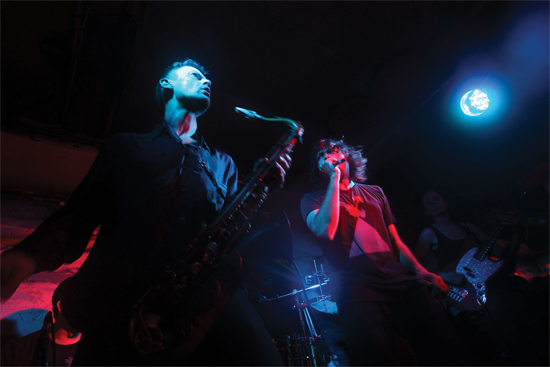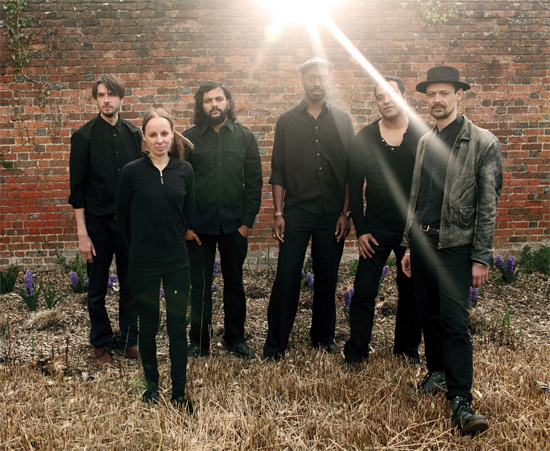It’s something of a surprise to learn that Pete Wareham’s never been to Egypt or Algeria, given that they’re the two main places he drew influence from in order to construct the frenzied rhythms and vibrant sonic colours of his new project Melt Yourself Down. The group features not just the former Acoustic Ladyland and some time Polar Bear saxophonist, but also long term Ladyland collaborator Ruth Goller on bass, Zun Zun Egui front man Kushal Gaya, tenor saxophonist Shabaka Hutchings and percussionists Tom Skinner and Satin Singh. Their self-titled debut album, produced by Leafcutter John, is a rambunctious, careering tumble of grooves and melodic flourishes, blown hot through with a blast of North-East African resonance. "But I haven’t been there that much," insists Wareham. "I played in Morocco once with Acoustic Ladyland for a jazz festival which was amazing. That’s about it."
Instead, Wareham – who meets me in the Ruby Lounge, Manchester, hours before Melt Yourself Down transform the unremarkable basement club into a writhing mess of bodies and hot hormones – has used this new project to re-imagine the Nubian region, with Melt Yourself Down like a collage of memories drawn from years of collecting the region’s sounds. "It’s always been the same with me," he explains. "My own music reflects what I’ve been listening to at the time, and with this stuff I’d been listening to it for 10 years without really expressing it myself, so it was getting to that point of needing to come out."
However, there was one track in particular that would prove a tipping point, shifting Wareham’s role from passive absorber to active re-constructionist. "I was DJing and played Ali Hassan Kuban’s ‘Habibi’ and the whole room came together, there was an amazing energy," he reveals. "So I decided to try and make something that felt as good as that: uplifting, action-packed and visceral." He called up the core of what would become his new band the next day and, predicting the gloriously fluid feel of the resulting record, tracks had already formed themselves by the end of first practise: "It was instant. The first rehearsal we played ‘Fix My Life’ and ‘Release!’ and they came together there and then."
On paper and in sound Melt Yourself Down – whose members are drawn together from other acts known for their collaborative tendencies – suggest a democratic creative process. Equally, the record’s clattering mix does part briefly at times to allow certain individuals to shine – the free flowing syncopated rhythms of Skinner that keep the record fixed on rails; Leafcutter John electronic treatments scattered throughout; Kush’s anarchistic verbal improvisations. However, its creation actually conformed strictly to Wareham’s own directorship. "It’s perhaps the least democratic process I’ve ever written under as a musician," he admits. "I’d write the song, make a demo of it and take it in to rehearse, or we would try to learn to play the demo and record that. Then I’d start editing the band rehearsal and chop that down. It always ended with me on my own chopping it up, putting it back together again, taking it in and tweaking the arrangements and stuff."
Wareham isn’t always the most eloquent when describing his work, but then, as he says in an email to me ahead of meeting up, "there doesn’t really need to be a great deal of ‘putting it into words’ to be honest." He’s a musician for whom the feel and spontaneity of creation has always outweighed theory and methodology. Acoustic Ladyland, the group he started with drummer and Polar Bear bandleader Seb Rochford in 2001, yielded four albums and a barrage of critical acclaim before their break-up in 2010. They sit apart from Melt Yourself Down stylistically, but the spirit of the two groups is similar: both’s music seems to flow, free and unchecked, direct from the subconscious.

Just as Acoustic Ladyland evolved naturally over time, pulling its frenetic meanderings in tight enough for some to tag ‘punk’ as being among their touchstones, so Melt Yourself Down surges forth with an ethos of ‘create first, re-visit later.’ It comes from an intrinsic place of energy, a subject which Wareham in conversation tiptoes around discussing, though never quite approaches directly. "With each tune I knew what I wanted it to do and what I wanted it to be, then it was just a question of hunting that down and doing whatever it took to bring that into focus," he says. "It’s just doing whatever the music seems to be asking you to do. My first attempts at writing these songs always came from just letting go and jamming and then returning and honing it afterwards. It’s a completely new way of writing for me."
Something else he’d written in our initial emails was the self-conscious need to constantly progress, to never stay in the same place musically, whether in the sound of the resultant work or the concepts and processes behind it. In person, he elaborates on this idea. "With Acoustic Ladyland, nearly all of it was written on the piano – apart from the saxophone melodies of course. But it wouldn’t be so much like jamming. Seb would always come up with better drum grooves after the ones I did for one, so the starting point would be the bassline. I was writing for a chord instrument as well, whereas with Melt Yourself Down the main part is written for a saxophone, which is a lot more natural for me."
The addition of Kush to the band – a union described as "a piece of cosmic brilliance" by Wareham – did provide a change in dynamic outside of Wareham’s direct jurisdiction, however. Melt Yourself Down started rehearsing in early 2012 at roughly the same time the colourful Zun Zun Egui character moved down to London. He joined with four of the tracks – ‘Camel’, ‘Release!’, ‘Fix My Life’ and ‘We Are Enough’ – having already been completed, and his contributions to those numbers scatter over their foundations. In the remaining songs, however, his contributions feel more slightly more in line with Wareham’s overall direction. "The second lot were written after Kush joined the band, so I wrote them with him in mind," Wareham comments. "I sent him my demos at a much earlier stage than the first four – which were done by the time he’d joined – so his vocals were much more integral to the music. He became more involved in this process of things."
Wareham is blessed to have musicians of such pedigree surrounding him, and he does hint that Melt Yourself Down is already evolving towards a more collaborative process. He’s keen to highlight the merits of his co-musicians even on a record of his own direction. "Everyone’s got their own thing and that’s great," he enthuses. "Tom Skinner’s brilliant for this sort of African-inspired music. I could say ‘here’s a Nubian rhythm, do this’ and he’d do it and also put his own rhythm on it as well. I know Satin from a Latin setting [Singh’s also appeared with everyone from Transglobal Underground to Supergrass and Denys Baptiste], so there’s that sort of influence in there as well. Ruth is very important as the only chord instrument that’s really holding it together, and she was great on expanding on what I’d already laid down. Shabaka’s been in Polar Bear a lot over the years, so we’ve always had a strong sort of connection and it meant I could make the two horns a unified thing."
In a group setting the dynamic is explosive, each musician crashing into each other with joyous abandon. Crucially, however, never with so forceful an impact as to leave the resultant songs bloated and misshapen. These are textures to entice, not alienate. "It’s energy," Wareham states simply. "We’re here to make you dance."
Melt Yourself Down is out now via The Leaf Label, and was voted as one of the Quietus’ favourite albums of the year so far. To read the full list, click here


